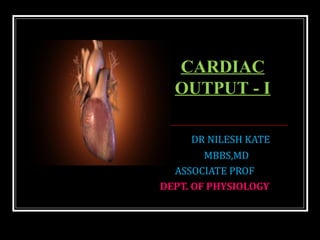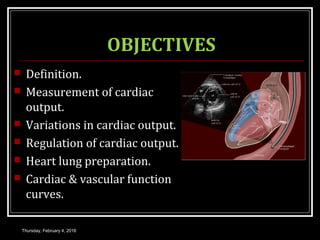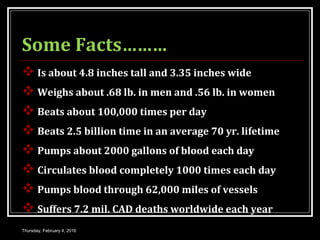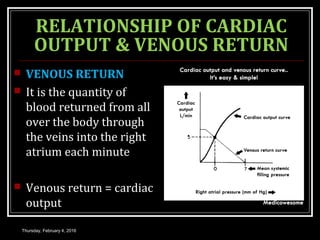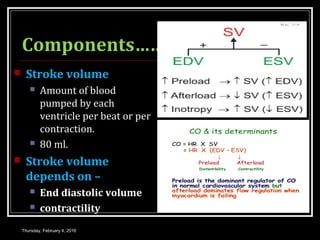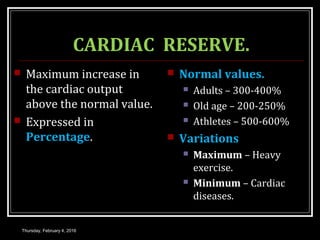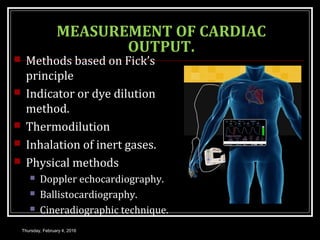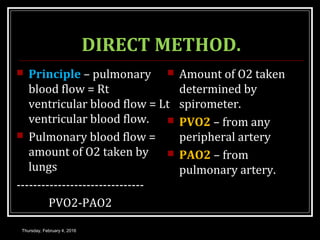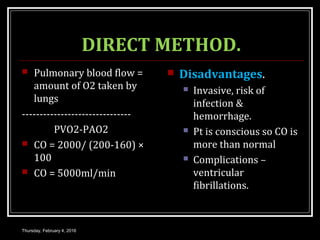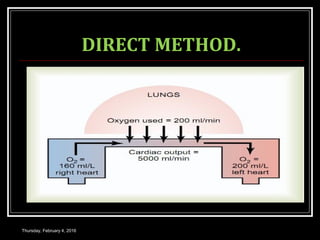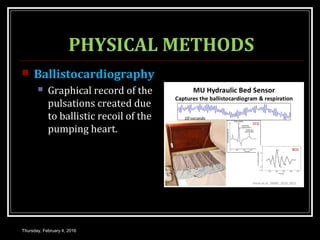Cardiac output 1
- 1. DR NILESH KATE MBBS,MD ASSOCIATE PROF DEPT. OF PHYSIOLOGY CARDIAC OUTPUT - I
- 2. OBJECTIVES Definition. Measurement of cardiac output. Variations in cardiac output. Regulation of cardiac output. Heart lung preparation. Cardiac & vascular function curves. Thursday, February 4, 2016
- 3. Some Facts……… Is about 4.8 inches tall and 3.35 inches wide Weighs about .68 lb. in men and .56 lb. in women Beats about 100,000 times per day Beats 2.5 billion time in an average 70 yr. lifetime Pumps about 2000 gallons of blood each day Circulates blood completely 1000 times each day Pumps blood through 62,000 miles of vessels Suffers 7.2 mil. CAD deaths worldwide each year Thursday, February 4, 2016
- 4. DEFINITION. Amount of blood ejected by each ventricle per minute. CO = SV * HR….. SV – Stroke Volume. HR – Heart rate. Cardiac output 80 * 70 = 5.6 L/min. Thursday, February 4, 2016
- 5. SIGNIFICANCE It’s the cardiac output that decides the rate of blood flow to the different parts of the body. Decrease in cardiac output Decrease in blood flow Thursday, February 4, 2016
- 6. RELATIONSHIP OF CARDIAC OUTPUT & VENOUS RETURN VENOUS RETURN It is the quantity of blood returned from all over the body through the veins into the right atrium each minute Venous return = cardiac output Thursday, February 4, 2016
- 7. Components……. Stroke volume Amount of blood pumped by each ventricle per beat or per contraction. 80 ml. Stroke volume depends on – End diastolic volume contractility Thursday, February 4, 2016
- 8. Components……. Heart rate Under normal circumstances 70 times/min. Increase in heart rate increases Cardiac output… but upto limit After it decreases due to decrease in Cardiac filling. Thursday, February 4, 2016
- 9. MINUTE VOLUME It is the amount of blood pumped out by each ventricle per minute. MINUTE VOLUME = Stroke volume x HR Normal value: 5litres/ventricle/minut e. Thursday, February 4, 2016
- 10. CARDIAC INDEX. Cardiac output is the amount of blood pumped out per ventricle per minute per square meter of body surface area. Expressed in relation to the body surface area. Normal value – 3.2L/min/m2 Thursday, February 4, 2016
- 11. CARDIAC RESERVE. Maximum increase in the cardiac output above the normal value. Expressed in Percentage. Normal values. Adults – 300-400% Old age – 200-250% Athletes – 500-600% Variations Maximum – Heavy exercise. Minimum – Cardiac diseases. Thursday, February 4, 2016
- 12. MEASUREMENT OF CARDIAC OUTPUT. Methods based on Fick’s principle Indicator or dye dilution method. Thermodilution Inhalation of inert gases. Physical methods Doppler echocardiography. Ballistocardiography. Cineradiographic technique. Thursday, February 4, 2016
- 13. METHODS BASED ON FICK’S PRINCIPLE Fick’s principle – Amount of substance taken up by an organ per unit of time (Q) is equal to the arterial level of the substance (A) – venous level of substance (V) × Blood flow(F) Q = (A-V) F F = Q ------- (A-V) 2 methods Direct Indirect Thursday, February 4, 2016
- 14. METHODS BASED ON FICK’S PRINCIPLE Thursday, February 4, 2016
- 15. DIRECT METHOD. Principle – pulmonary blood flow = Rt ventricular blood flow = Lt ventricular blood flow. Pulmonary blood flow = amount of O2 taken by lungs ------------------------------- PVO2-PAO2 Amount of O2 taken determined by spirometer. PVO2 – from any peripheral artery PAO2 – from pulmonary artery. Thursday, February 4, 2016
- 16. DIRECT METHOD. Pulmonary blood flow = amount of O2 taken by lungs ------------------------------- PVO2-PAO2 CO = 2000/ (200-160) × 100 CO = 5000ml/min Disadvantages. Invasive, risk of infection & hemorrhage. Pt is conscious so CO is more than normal Complications – ventricular fibrillations. Thursday, February 4, 2016
- 17. DIRECT METHOD. Thursday, February 4, 2016
- 18. INDIRECT METHOD. Same as direct method only CO2 excretion by lungs is measured by spirometry. PACO2 from alveolar air. PVCO2 – Rebreathing into closed bag. CO = CO2 output/min ---------------------- PACO2-PVCO2 Thursday, February 4, 2016
- 19. INDICATOR OR DYE DILUTION METHOD. Principle – Known amount of dye injected into Rt atrium & mean concentration of its first passage through an artery is determined. Blood flow (F)= Q/Ct F = blood flow in L/min. Q= quantity of dye injected. C = Mean Conc. of dye. T = Time duration in sec of first passage of dye. Thursday, February 4, 2016
- 20. IDEAL INDICATOR. Should be nontoxic. Mix evenly. Easy to measure. Not alter cardiac output or haemodynamic. Not be changed by body. E.g. Evan’s blue, radioactive isotopes. Thursday, February 4, 2016
- 21. PROCEDURE. 5 mg of Evan’s blue dye mixed with venous blood. Duration of first passage of dye(t) & mean conc of dye (C) in arterial blood estimated. CO= Q/ct × 60 = 5/1.5L ×40 × 60 = 5 L/min Thursday, February 4, 2016
- 22. THERMODILUTION PRINCIPLE – same as indicator dye dilution method except cold saline is used. Resultant change in blood temperature in pulmonary artery is determined. Thursday, February 4, 2016
- 23. INHALATION OF INERT GASES. NO, Acetylene – used. Pulmonary blood flow is determined from following values Quantity of gas absorbed in given time. Partial pressure of gas in alveolar air. The solubility of gas. Thursday, February 4, 2016
- 24. PHYSICAL METHODS Doppler echocardiography – Ultrasonic evaluations of cardiac functions. B-scan ultrasound at a frequency of 2.25 MHz using a transducer. Measure EDV, ESV,CO & Valvular defects. Thursday, February 4, 2016
- 25. Thursday, February 4, 2016
- 26. PHYSICAL METHODS Ballistocardiography Graphical record of the pulsations created due to ballistic recoil of the pumping heart. Thursday, February 4, 2016
- 27. PHYSICAL METHODS CINERADIOGRAPHIC TECHNIQUE. The making of a motion picture record of successive images appearing on a fluoroscopic screen. Radiography of an organ in motion, for example, the heart, the gastrointestinal tract. Thursday, February 4, 2016
- 28. VARIATIONS IN CARDIAC OUTPUT. Physiological causes. Age – CI children > adult. Sex – females > Males Diurnal variations- low in early morning. Environmental temperature – direct relation. Anxiety excitement, Eating, Exercise, Pregnancy, High altitude – direct relation. Posture change – sitting or standing > lying down due to venous pooling. Thursday, February 4, 2016
- 29. VARIATIONS IN CARDIAC OUTPUT. Pathological – its mainly due to low peripheral resistance Increase Fever Anemia. Hyperthyroidism. Beriberi Arteriovenous fistula Thursday, February 4, 2016
- 30. VARIATIONS IN CARDIAC OUTPUT. Decrease CCF Rapid arrhythmias Cardiac shock Incomplete heart block Hemorrhage Hypothyroidism. Thursday, February 4, 2016
- 31. Thank you. Thursday, February 4, 2016

